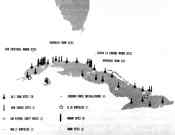
The Cuban Missile Crisis
October, 1962
The closest the world ever came to its own destruction was the event known to us as the Cuban Missile Crisis. In Cuba this event is known as the October Crisis of 1962, and in the former Soviet Union it was known as the Caribbean Crisis.
For nearly two weeks the U.S. and the Soviets stood on the brink of nuclear war, and only the leadership of Kennedy and Khrushchev kept the crisis from escalating into a full nuclear war.
For many of us the Cuban Missile Crisis seems like a legend from the past, yet it has continually baffled historians with every new bit of information declassified and each new memoir or re-examination published.
We know that the Kennedy brothers were largely responsible for the positive outcome. Not only were they able to resist the war lust and manipulations of the Joints Chiefs of Staff (JCS), but they were able to maintain peace and not fire their weapons. This was not easy.

We also know that Khrushchev had similar problems with his war machine, and he also managed to overcome them.
This website will not try to tell the whole story of the crisis. Instead it'll point you to books and websites that will help you get a more complete perspective on the crisis, its reasons, and the aftermath.
Explore the Cuban Missile Crisis
|
The Timeline Books About the Crisis Missile Crisis Gallery The Cuban Missile Crisis on the Web Lessons of the Missile Crisis - An excerpt from: SAD AND LUMINOUS DAYS: Cuba's Secret Struggles witht the Superpowers After the Cuban Missile Crisis |
Letters:
|
CUBA'S PERSPECTIVE: Conflict Averted but Crisis Endures
By James G. Blight and Philip Brenner
Although the October Crisis was the one that brought Cuba closest to the brink of devastation-by way of either a nuclear conflagration or a U.S. invasion-it was one of many crises between Cuba and the United States in the fist years of the Revolution. Though each actually does not have its own designations, Cubans say that they distinguish among them by reference to the date when they occurred; this one happened in October. Their name for the crisis thus highlights Cuba's ongoing conflict with the United States, which they argue led to the confrontation over the missiles. But from the Cuban perspective, it was Soviet-U.S. interests that defined the terms by which the actual conflict was avoided. By serving their own interests and not addressing the Cuban-U.S. conflict, the two superpowers thus did not resolve the underlying causes of the missile crisis.
From:
SAD AND LUMINOUS DAYS: Cuba's Secret Struggles witht the
Superpowers After the Cuban Missile Crisis
Rowman & Littlefield
Publishing Group, Inc.
Related: Bay of Pigs
Return to 1962